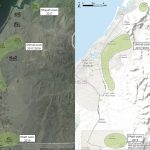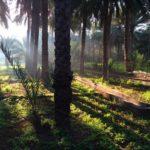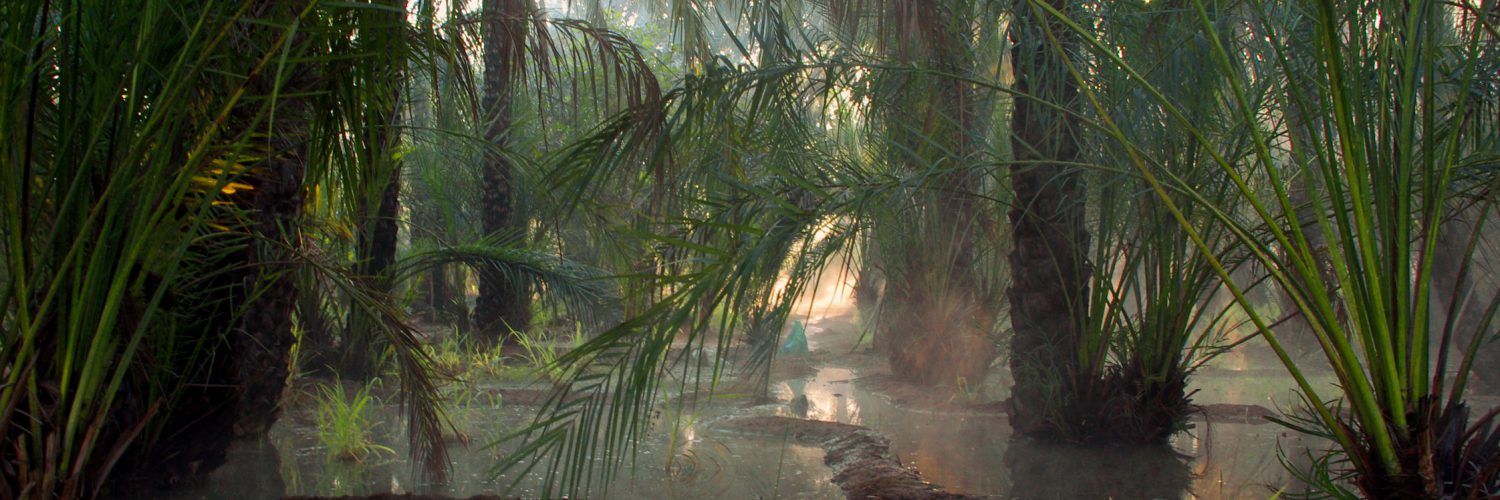Masafi project (United Arab Emirates)
Field director: Julien Charbonnier
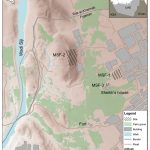
Map of Masafi oasis with location of protohistoric sites (© Opération Masafi, M. Régagnon et C. Calastrenc)
Carte de l’oasis de Masafi montrant la localisation des sites protohistoriques (© Opération Masafi, M. Régagnon et C. Calastrenc)
The oasis of Masafi has been investigated by the French Archaeological Mission in the United Arab Emirates since 2006, under the supervision of Anne Benoist and, from 2016, of Julien Charbonnier. The aim of the project, funded by the French Ministry of Foreign Affairs, is to apprehend the spatial organization of a protohistoric community from the mountains of Southeast Arabia, and its evolution over the last two millennia BC.
Masafi is a strategic place, as it is located at crossroad of several trade routes and as it benefits from mining and water resources. Three archaeological sites dated from the Iron Age (1100-600 BC) were excavated so far: an unprecedented terraced settlement, a cultic place and a collective building. They were distributed around a cultivated area, which has been identified under the present-day palm grove thanks to a multidisciplinary approach. Crops were fed by runoff water to the east and wells to the west.
From 2017 to 2020, the project will focus on the Middle and Late Bronze Age (2000-1300 BC), a period that remains little-known in the region. Our objective is to document and analyze the cultural changes of the 2nd millennium BC and the transitions to the Iron Age. Two settlement sites will be investigated, with the assistance of the Fujairah Tourism and Antiquities Authority and the Ras al-Khaimah Department of Antiquities and Museums. The economic foundation of these sites, agriculture and crafts, will be addressed through detailed studies.
Objectives per year
Year 1 – 2017
The excavation of Masafi-5 (1400-1200 BC), located south of the oasis, will be pursued during the first year of the program. This operation will aim at defining and understanding the transition between the Late Bronze Age and the Iron Age, thanks notably to pottery studies. Geoarchaeological researches will have to recognize the agrarian and hydraulic practices contemporary with the site. A new excavation will also be opened near Masafi-3, in order to investigate cultivated layers from the early Iron Age, previously identified through test pits. The geomorphological survey and the ethnographic study of the oasis will be continued.
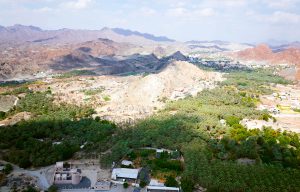
Aerial view of Masafi oasis (© Opération Masafi, Thomas Sagory).
Vue aérienne de l’oasis de Masafi (© Opération Masafi, Thomas Sagory).
Year 2 – 2018
Excavation at Masafi-5 and near Masafi-3 should be completed during the second year of the program. Test pits will be dug in the settlement Masafi-4, which is located north of the oasis (Ras al-Khaimah), in order to evaluate the depth of archeological layers and plan future operations. The geoarchaeological study will focus on the northern part of the oasis. The geomorphological survey and the ethnographic study of the oasis will be continued.
Year 3 – 2019
The third year of the program will be devoted to the excavation of Masafi-4, which was occupied in the first half of the 2nd millennium BC. It is a crucial site to characterize this period at a regional level and study the cultural transitions from the Middle Bronze to the Late Bronze Age. The last geoarchaeological test pits will be opened to the north of the oasis. The geomorphological and ethnographic studies should also be completed during Year 3.
Year 4 – 2020
The last year of the program will be devoted to the completion of Masafi-4 excavation and of the paleoenvironmental analyses. The final monograph will be initiated.
Field team
- Julien Charbonnier (director), archaeology & ethnoarchaeology
- Anne Benoist, archaeology
- Louise Purdue, geoarchaeology
- Sophie Costa, geoarchaeology
- Aline Garnier, phytolithology
- Hatem Djerbi, malacology
- Maël Crépy, geomorphology
- Gourguen Davtian, geomatics
- Thomas Sagory, geomatics
- Clément Virmoux, geophysics
Lab team
- Ian Bailiff, OSL dating
- Lisa Snape-Kennedy, OSL dating
- Frank Preusser, OSL dating
- Thierry Blasco, chemistry
- Arnaud Mazuy, chemistry
- Linda Herveux, palaeobotany
- Alain Carré, palaeobotany
Traduction française : Opération Masafi (Émirats Arabes Unis)
Responsable : Julien Charbonnier
Présentation du projet
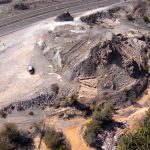
Aerial view of Masafi-5 (© Opération Masafi, Thomas Sagory).
Vue aérienne du site de Masafi-5 (© Opération Masafi, Thomas Sagory).
La Mission Archéologique Française aux Émirats Arabes mène depuis 2006 des recherches dans l’oasis de Masafi, d’abord sous la direction d’Anne Benoist, puis de Julien Charbonnier à partir de 2016. L’objectif de ce projet, financé par le MAEDI, est de reconstituer l’organisation territoriale et l’évolution d’une communauté protohistorique dans les montagnes d’Arabie du sud-est au cours des deux derniers millénaires avant l’ère chrétienne.
Masafi constitue un lieu stratégique du fait de sa localisation, au carrefour de plusieurs axes d’échanges, et de ses ressources hydriques et minières. Trois sites datés de l’âge du Fer (1100-600 av. J.-C.), à savoir un habitat inédit en terrasses, un lieu de culte et un bâtiment collectif, ont jusqu’à présent été fouillés. Ils s’organisaient autour d’une zone cultivée, alimentée par les eaux de ruissellement à l’est et des puits à l’ouest, qui a pu être cartographiée et étudiée grâce à une approche pluridisciplinaire.
De 2017 à 2020, le calendrier de recherche est axé sur la fin de l’âge du Bronze (2000-1300 av. J.-C.), une période très peu connue archéologiquement au niveau régional. Ce programme doit notamment permettre de mieux documenter, dater et comprendre les évolutions socio-économiques ayant marqué le 2e millénaire avant J.-C. et la transition avec l’âge du Fer. Deux sites d’habitats seront fouillés, avec le soutien de la Tourism and Antiquities Authority de Fujairah et du Department of Antiquities and Museums de Ras al-Khaimah. Afin de reconnaître les fondements économiques de ces établissements, les paysages agraires et les techniques artisanales (céramique et métallurgie du cuivre) vont faire l’objet de programmes d’étude approfondis.
Objectifs par année
Année 1 – 2017
La première année du programme de recherche est consacrée à la poursuite de la fouille du site de Masafi-5 (1400-1200 av. J.-C.), localisé au sud de l’actuelle oasis. Il s’agit principalement de mieux cerner la transition entre l’âge du Bronze et l’âge du Fer, grâce notamment à l’étude du matériel céramique. Des sondages géoarchéologiques, implantés à proximité de Masafi-5, devront permettre de reconnaître les pratiques agraires et hydrauliques contemporaines du site. Plus au nord, près de Masafi-3, une zone cultivée du début de l’âge du Fer, doit par ailleurs être fouillée. Parallèlement, la prospection géomorphologique régionale sera continuée, de même que l’étude ethnographique de l’oasis.
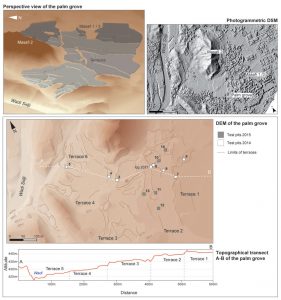
3D model and DEM of the southern part of Masafi oasis (© Opération Masafi, M. Régagnon et C. Calastrenc)
Modèle 3D et MNT de la partie sud de l’oasis de Masafi (© Opération Masafi, M. Régagnon et C. Calastrenc)
Année 2 – 2018
Les fouilles de Masafi-5 et de la zone cultivée près de Masafi-3 seront achevées lors de la deuxième année du programme. Des premiers sondages seront ouverts sur le site de Masafi-4, localisé au nord de l’oasis (Émirat de Ras al-Khaimah), afin d’évaluer l’épaisseur des dépôts anthropiques et de préparer les futures fouilles. La partie nord de la palmeraie sera sondée à la recherche de traces d’activités agricoles passées. La prospection géomorphologique régionale et l’étude ethnographique de l’oasis se poursuivront.
Année 3 – 2019
À partir de la troisième année du programme, Masafi-4, occupé au début du 2e millénaire av. J.-C., sera l’objet de toute notre attention. Notre objectif est de mieux caractériser cette période au niveau régional et d’étudier les transitions culturelles entre le milieu et la fin de l’âge du Bronze. Les derniers sondages géoarchéologiques seront ouverts au nord de l’oasis. La prospection géomorphologique et l’enquête ethnographique seront achevées.
Année 4 – 2020
La dernière année du programme sera consacré à l’achèvement de la fouille de Masafi-4, à celle des analyses paléo-environnementales et à la préparation de la monographie finale.
